I’ve been putting together some projects to write up for my next ebooks. And I actually had a little project today that turned out really well. I thought maybe you’d like to get a free “how to” on how to repair a chipped ceramic piece.
I have a huge old blue-sponged mixing bowl, marked “Robinson Ransbottom, Roseville OH, U.S.A., mixing bowl, 15″ 8 qt.” on the bottom. I’ve had it forever. Someone saw it at my indoor tag sale. I’d forgotten to put it out! (You can see more of the goodies at my online sale gallery.
She wanted to take a closer look. But when my husband brought it down from the cupboard, I found a new chip in the glaze.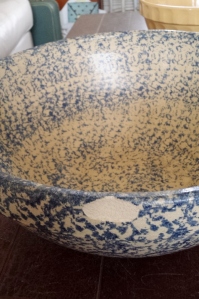
I was heartsick. The value of this bowl is at least $75. The chip is mostly on the outside of the rim, and won’t affect its usefulness. But it does look bad. (image 1)
Now usually I would take a blue magic marker to something like this. Simply coloring the exposed brighter clay would go far to make the chip less noticeable.
But then I tried a trick I’ve used before.
When a piece gets knocked or notched–a china ear chips off, or a chunk is missing, I actually use POLYMER CLAY to fill it in.
Here’s how you do it:
Materials:
Polymer clay in a matching color. (I used a clay color that matched the base glaze color, and blue acrylic paint for the sponged pattern.)
Super glue (image 3)
CA activator, Zip Kick activator spray or any other super glue activator (Trust me, this item will be your new best friend when it comes to using super glue!) (image 4)
A piece of rough sandpaper and a small block of wood (I used a rubber stamp because I was too lazy to look for a little block of wood.) (image 5)
3M wet/dry sanding sponge, fine, superfine or ultra fine. (image 5)
Acrylic paint to match (You can use this to paint the entire baked patch, or to recreate a pattern or design like I did) (image 8)
Small paint brush (like tiny small) (image 9)
Paint sponge (or tear off a big chunk of a kitchen sponge and use that.) (image 11)
Soft cloth (I used a kitchen towel because it was there.)
Instructions:
Step 1: Use a chunk of polymer clay in a matching color, or mix to match. In this case, “champagne” was an almost perfect match for the glazed stoneware base glaze. I conditioned it by kneading it until it was malleable, and pushed it into the chipped area. This is what it looked like (Image 2):

Really push the clay into the chipped space. You want a good contact with the clay surface for a good fit.
Step 2: Gently remove your lump o’clay patch. Try not to deform the lump. Bake it in your firing oven at 265 degrees (or the manufacturer’s recommendation) for 30 minutes. Let cool and remove from oven.
Step 3: Apply glue to the object’s surface. (image 3) (You can apply glue to either surface, but I figured it would be easier to work with a glue-free chip-filler blob. You may be more careful than I usually am.) Remove the cap from your glue activator. (Image 4)
What does the glue activator do? It makes super glue set INSTANTLY.
The problem with many super glue repairs is, it takes pressure and a bit of time for the glue to set. Although it’s supposed to be “instant”, sometimes it just takes a little longer. But move the patch before it’s dry, or if it isn’t lined up exactly, the attached piece will pop off.
When you spritz the glued area with the activator, the activator will seep into the glued area and INSTANTLY set the glue. It ensures a faster, more reliable adhesion.)
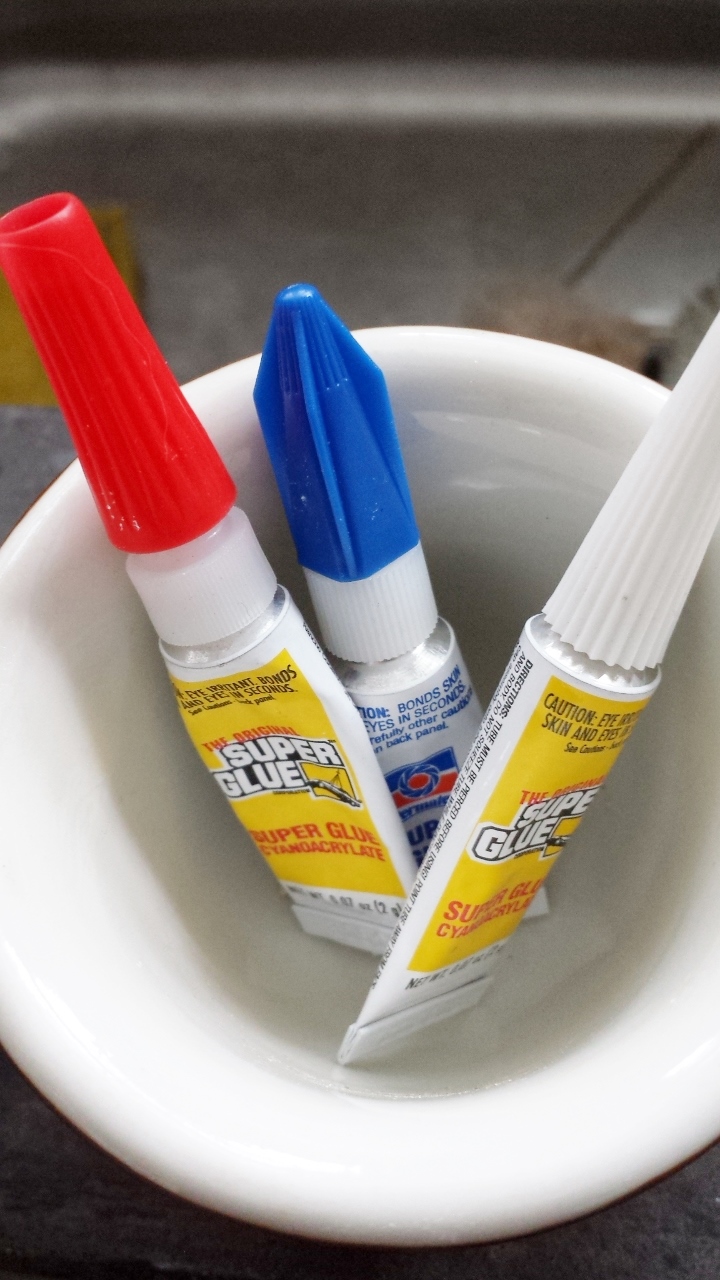
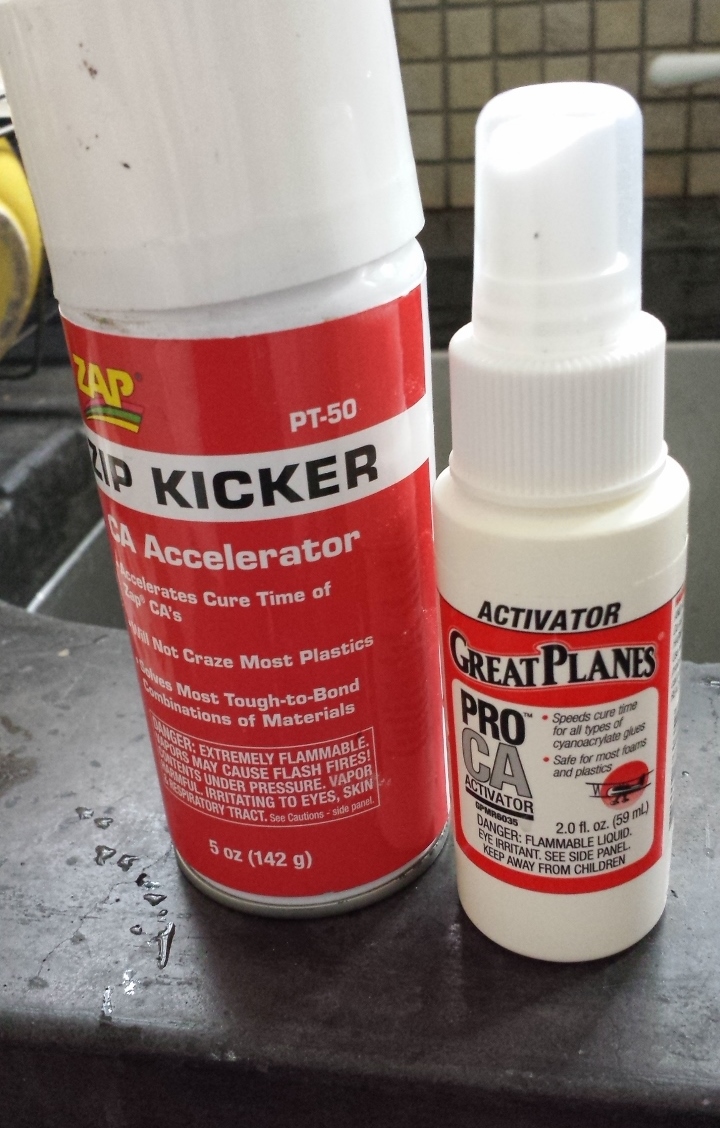
Step 4: Line up the patch with the chip, and press the patch/chip-filler as hard as you can with one hand. With your other hand, spritz along the EDGE of your patch, as if you were trying to squirt into the tiny space between the patch and the chip. (This is why you need to have the activator cap off beforehand. Trust me. I’ve learned the hard way.)
The patch should stick instantly.
If it doesn’t, apply a drop of glue to an area that are free of the first glue try, and try it again. (Glue won’t stick to glue.) You only need a tiny area to “catch” to make an effective patch.
So now you have a glob of baked clay stuck to your bowl. What now?
Step 5: Now we’re going to sand it down to match the surface shape of the bowl. For a large smooth profile like the bowl, rough sandpaper wrapped around a hard, flat thing (like a little block of wood!) will help you smooth and shape the surface of the patch. (image 5)

You’re removing enough patch mass (a new phrase!) to fit in the the bowl’s original profile. (image 6) Stop before you’ve gone TOO far, though! You can always take off more, but you can’t add it back in later. 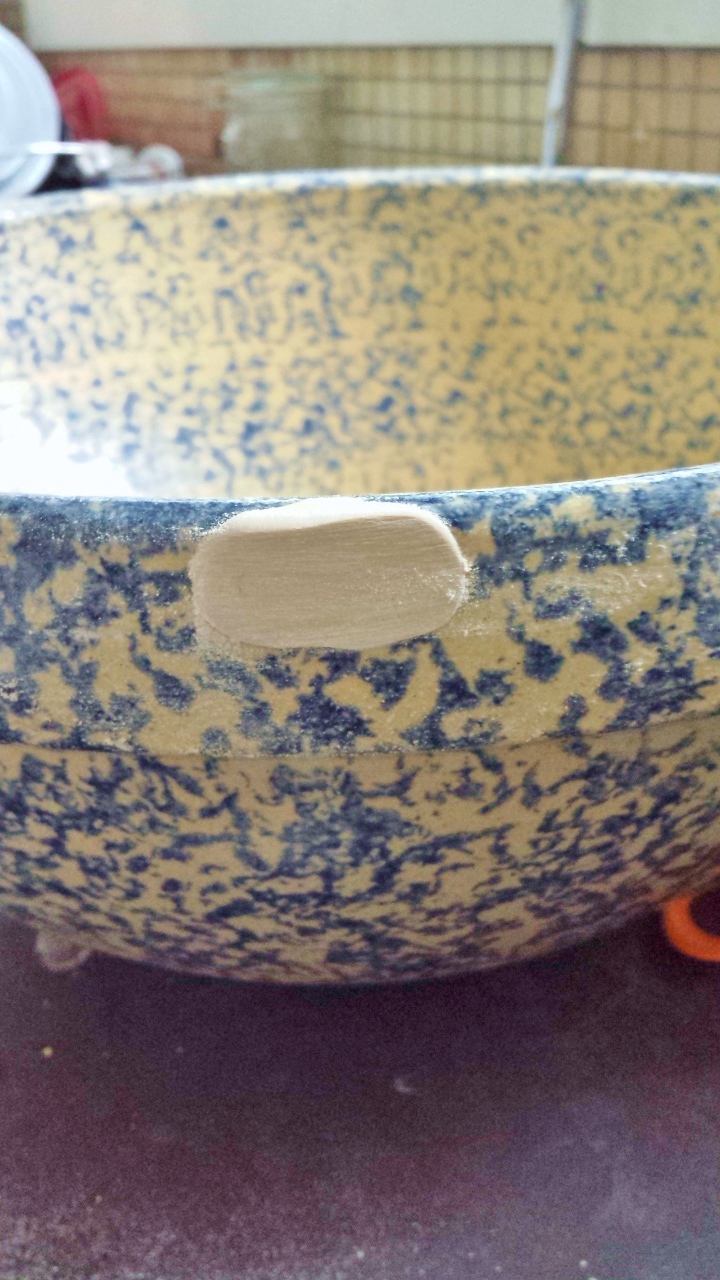
When you’re pretty close to matching the surrounding surface, switch to the finer sanding sponge. Polymer clay sands smoother and faster with water (since it tends to gum up sandpaper quickly), so dampen the sanding sponge if you’d like.
Polymer doesn’t have a grain, so it won’t matter what direction you sand it in. You can go vigorously (especially with the dry sandpaper) until you are within shaping-range. And focus on the patch, not the rest of the bowl. Glaze is really tough and hard to scratch. But you don’t want to test that, either!
I used a circular motion around the edges of the patch, so I could REALLY smooth them out.
When you’re finished, the patch should feel almost seamless to the touch.
And it should look like this (image 7) :
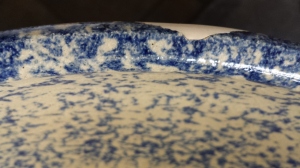
Now, if you were mending a solid color item, and you used a patch made with clay that matches it, you could stop here.
But we have a sponged design on the bowl, and the repair is still obvious. I COULD have used a blue patch, and it would have been less noticeable. But I wanted to see if I could actually….
Step 6: Paint the patch! So here are the paints (image 8):
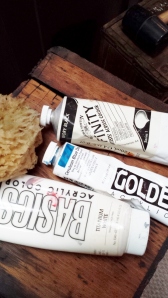
You need very little paint to sponge, so just a tiny squish of each color ought to do it. (image 9)
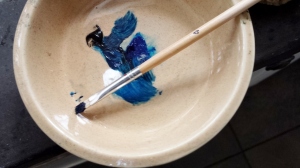
I still didn’t have the right shade of blue. Maybe purple….? But do I have any purple? I hardly ever use that color….
Yes! (image 10) 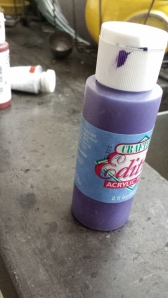
And now for the sponge (image 11).
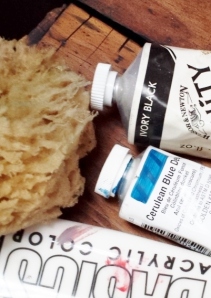
Step 7: Wet the painting sponge (not the sanding sponge!) and squeeze it nearly dry. Dab it into your paint and test with a piece of white paper. (I forgot this, so I just grabbed a paper towel.) After you experiment a little, you’ll get a feel for how much paint, how hard to sponge, etc.

Sponge your patch! (image 11) As you can see, I put on a lit-tul too much. (image 9) I should have quit sooner. But it still looks pretty awesome, doesn’t it?
Step 8: Let the paint dry thoroughly, then buff with a soft dry cloth. This will shine up the paint a little, enough to match the soft shine of the bowl itself.
Now….can you see the patch? (image 10)
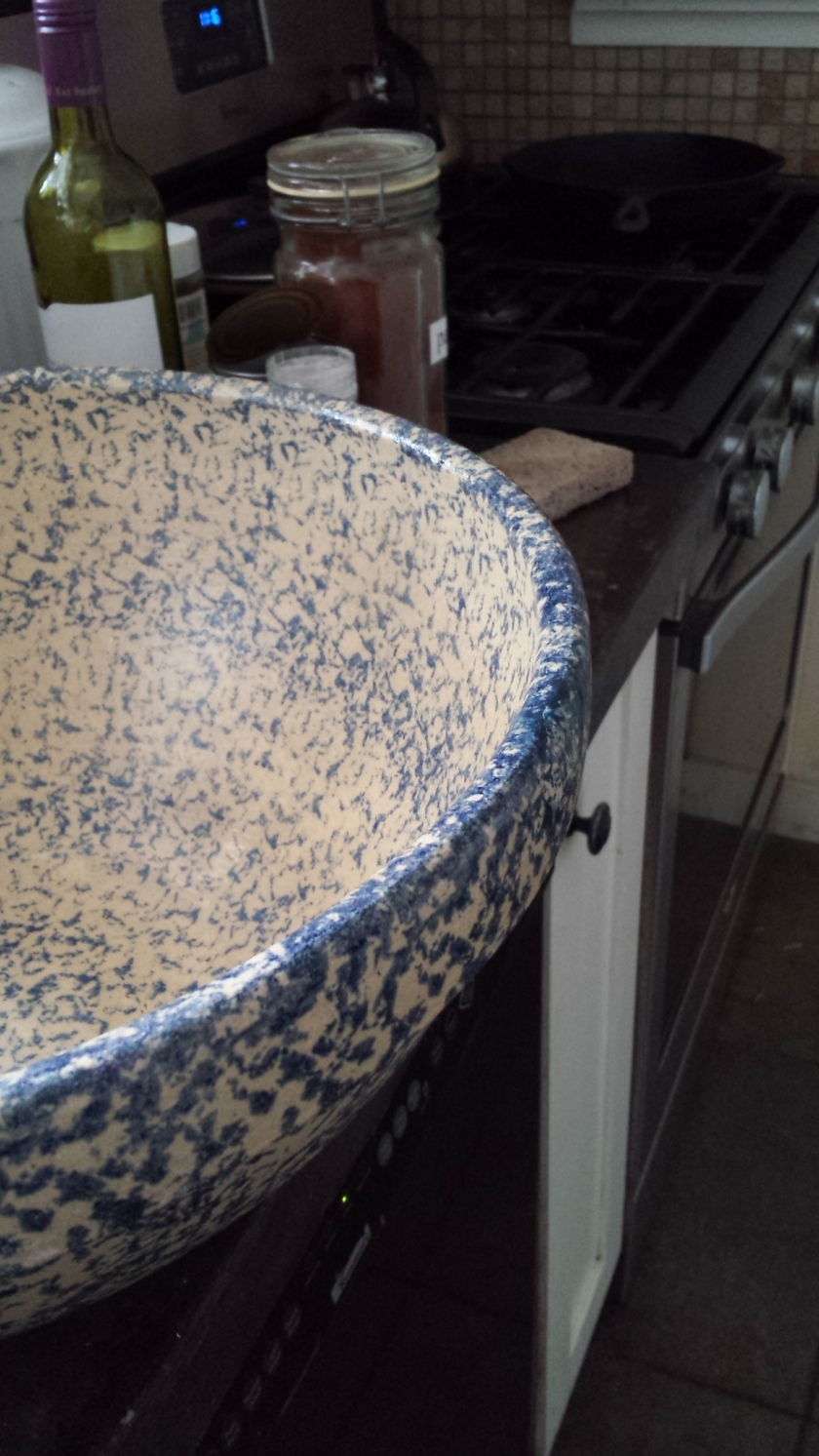
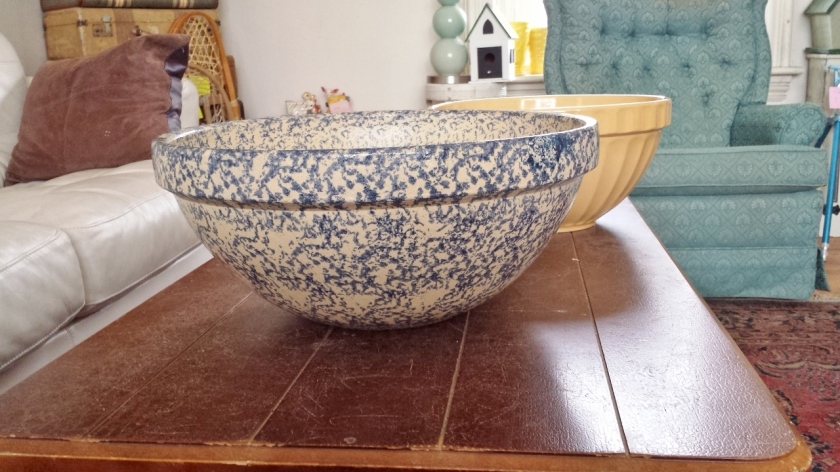
Can you see it here? (image 11)
Now for the hard question: How durable is this repair? And how safe is it for food purposes?
I wouldn’t bake this bowl. The polymer clay is safe to heat up to 300 degrees or so. But it can scorch at higher temperatures. But why would you bake a mixing bowl???
How durable is the paint treatment? I use acrylic paint as a glaze on my handmade artifacts. I DON’T use any glazes or finishes over the paint–just polishing with a power buffer. Some of them have gone through the laundry, or into hot tubs, or swimming, and the paint has been okay. I think the polishing, even with just a cloth, helps shine and “seal” the surface somewhat. But I wouldn’t put this bowl in a tub of soapy dishwater, nor put it in the dishwasher. (But it’s too big for a dishwasher anyway!)
It’s food-safe, so you can certainly use the bowl to hold stuff: Fruit (real and faux), billiard balls (!!), and so on. If you use it to actually mix stuff, I would wash and rinse carefully, making sure not to scrub or soak the patched area.
But it’s still an easy, affordable, effective patch. And I’m delighted with the results!
(Author’s note: I apologize for the awkward formatting. I have never figured out how to layout images and text with WordPress, despite constant experimenting and positioning. If anyone knows of a good tutorial, point me at it!)


Thank you!
LikeLike
Thank you Sue. However, I have a similar problem but your method won’t work in my case. I have a Romertopf unglazed pot. It is intentionally unglazed for the cooking method. I have a very fine crack. I need something that can go into the oven, and be food safe. I really don’t care how it looks, I just care that it performs well. Any suggestions?
LikeLike
Lisa, I don’t work in ceramics,but I googled your question and found this: Quite a few articles came up in the search. I hope one of them is useful for you!
LikeLike
Thank you. I was hoping I could fine a way to fix my Great Grand mother’s 200 year old cats ear.
Carol Allen
LikeLike
I hope it was helpful, let me know.
LikeLike
This is so timely…I chipped a large piece off a gorgeous handmade birdbath…have glued back what I could but couldn’t figure out how to fill in the gaps with polymer clay. Now thanks to your article I will go ahead 🙂
LikeLike
Can you tell me when you use the CA accelerator versus the CA activator – it is the same thing?
LikeLike
I googled your question and yes, they are the same.
LikeLike
How clever of you to think of this. Thank you for sharing.
LikeLike
Great Job! Thanks for sharing.
LikeLike
We inherited a valuable antique vase from my husband’s parents – a wedding present – but were dismayed to find it had two chips missing, one on the base and another on the pouring lip unfortunately on the other side. I have long wondered how I could rescue this beautiful china vase and now I have the answer! Thank you so much, I look forward to seeing our inheritance returned to its former perfection!
LikeLike
Reblogged this on randyontheglobe and commented:
I have a couple of pieces of pottery with minor chips. This tutorial offers a not-too-intimidating solution that seems realistic… and a good excuse to take Christopher to Michael’s.
LikeLike
Just FYI, it’s always a good strategy to check with the original author (me!) before you repost on your own site. . And most of will ask that you write a paragraph of your own as an intro, then add the first paragraph of the article, with proper attribution, then LINK to the original post. You did this two months after we moved to California, after 24 years in NH, and it kind of fell off my radar. I followed your link to your blog, and didn’t see my name or a link back to my blog anywhere. In the future, first, please check in with the author and ask permission. Second, always give credit where credit is due. I can’t tell you how many times people have reposted my articles in to on their own blog, and even with proper accreditation, their readers still think THEY wrote it. Just not a kind thing to do. I hope you choose to do better next time. But I do hope this tutorial helped you with your own pottery stuff.
LikeLike
We are wood turners using a lathe so are familiar with lots of your items . Your tutorial is great! Think about the Folk School in Brasstown, NC, you are a great teacher. Joanne
LikeLike
So glad you liked the article (high praise from woodturners!!) Um…is there a commuter flight to NC?
LikeLike
I have old flower vase with clay flower I want to renovate the vase removing flowers can u suggest how can I do that
LikeLike
I am so sorry I can’t help you with that. This is an article with a very narrow focus on repairing minor chips in pottery.
LikeLike
Thank you for the article, though it was a number of years ago. Do you have any tips to remove he polymer clay without deforming it? I am trying to repair a pot and I’ve baked deformed clay that won’t fix the chip. It’s on the rim of the pot, the outside rim and the inside rim. (It’s actually a painted clay pot used for flowers) I have pictures, that might help.
LikeLike
Yes, send some pictures. Did you see step 5? I put on too much polymer, then sanded the patch to fit. If your patch is too small, you can add more clay right on top of it, back it again, superglue it on (if it didn’t have time to self-stick to the original patch), and sand it down.
LikeLike
Would you recommend using this technique for a coffee mug? One of my favorites is chipped on the inside rim. I could just cry. 😦
LikeLike
Ummmmm….not sure. Polymer clay is inert once it’s baked, but still not generally recommended for food use. And the heat might eventually undo the superglue. So if it’s for display, yes. For daily usage? I can’t recommend that, because I’m not that expert! I’m sorry for your loss, I get the favorite mug thing!
LikeLike
I have a wonderful British bean pot. It is 51 years old and was perfect until yesterday! I took baked beans to a party and someone decided to strike the rim of the pot with a metal spoon resulting in a large chip. I could have cried! I need a repair job that allows me to put the
It in the oven. Anyone out there able to help me?
LikeLike
Unfortunately, I’m not sure how the superglue would hold up to oven temperatures. My suggestions would be to find a ceramic artist in your area and ask for their advice, or check in with an antique store and ask if they know someone who repairs/restores ceramics. Or….Google it! I hope this helps, good luck!
LikeLike
Have just tried a similar patch in chips on the bottom of a ceramic bowl. Based on the company’s strength chart I chose Premo white; translucent would also work, perhaps a mix of both to get near-exact match. I dabbed a drop of their Bake & Bond adhesive onto the chip area, then a dab onto a chewing gum sized glob of clay as well. Kneaded it to get soft and mix the glue in, then worked it onto the chip gouges until I was satisfied I had a smooth patch that slightly exceeded the surrounding area. Baked for 30 min at 275 in a toaster oven, and so far it looks solid. In a day or two I’ll sand it and see how well it bonds. The Bake & Bond is supposed to hold baked and raw clay but has to be baked to set; I’ve used thin super glue to penetrate cracks, with very good success, but it is not totally waterproof, and can’t be taken above about 200 F. My direct patch solves the issue of trying to glue a pre-shaped and baked patch onto a chipped area, and it looks quite good. Time will tell. As long as one is patching real pottery or dishware that was fired at real kiln temperatures, 275 is not a problem at all.
LikeLike
Rusty update: The small patch held for about six months, then fell off. It was only about 1/4″ area. I am going to experiment next with straight Bake & Bond to repair three broken mug handle pieces, and see if that will hold during baking, then how strong it is after baking. No one has noted that even low-temp ordinary pottery is fired many hundreds of degrees above Sculpey temperatures, so many options are open when it comes to repairing or adding ornaments to anything that can withstand the 300 degrees of these modeling materials. They advise B & B be applied between the baked base surface, and the added material, which can either be fresh soft clay or previously baked items. We’ll see; if it provides a stronger, baked, permanent bond, it should be preferable to any separate glue or adhesive?
LikeLike
Hi..I have an antique china sugar bowl, the lid handle is broken and lost, could I use the clay to form a handle and ten glue it on and paint it?
LikeLike
Hi Ann, thank you for your patience, I just found this comment! Yes, you can. :^)
LikeLike
Thank you. I was hoping I could fine a way to fix my Great Grand mother’s 200 year old cats ear.
Carol Allen
LikeLike
HI! Will this method work on stoneware?
LikeLike
Probably. I think Rosewood pottery IS stoneware, but I’m not an expert in ceramics. Be sure to check the caveats, this technique is more about aesthetics than function. Good luck!
LikeLike
Thank you. This is a really useful piece with lots of sentimental value.
LikeLike
Most pottery is fired at LEAST 1400+ F so you can just bake the clay with the pottery – you won’t damage it at the low oven temps used for polymer clay.
LikeLike
Did I say that in the article?? Geez, I DO know that, I’ll look for the goof & edit. Thank you!
LikeLike
OK, I see what you’re getting at here. Yes, we can bake the clay while attached to the bowl. It won’t hurt the bowl. BUT in this case, the bowl was too big to put in our oven! Hence, curing the polymer clay at the manufacturer’s recommended temp. Also, if the polymer clay is applied in a weird place, it could fall off the pottery and get bumped/bent/slack a bit. That surface of the polymer clay exactly matching the pottery clay is the most critical part. Hope that explains it better!
LikeLike